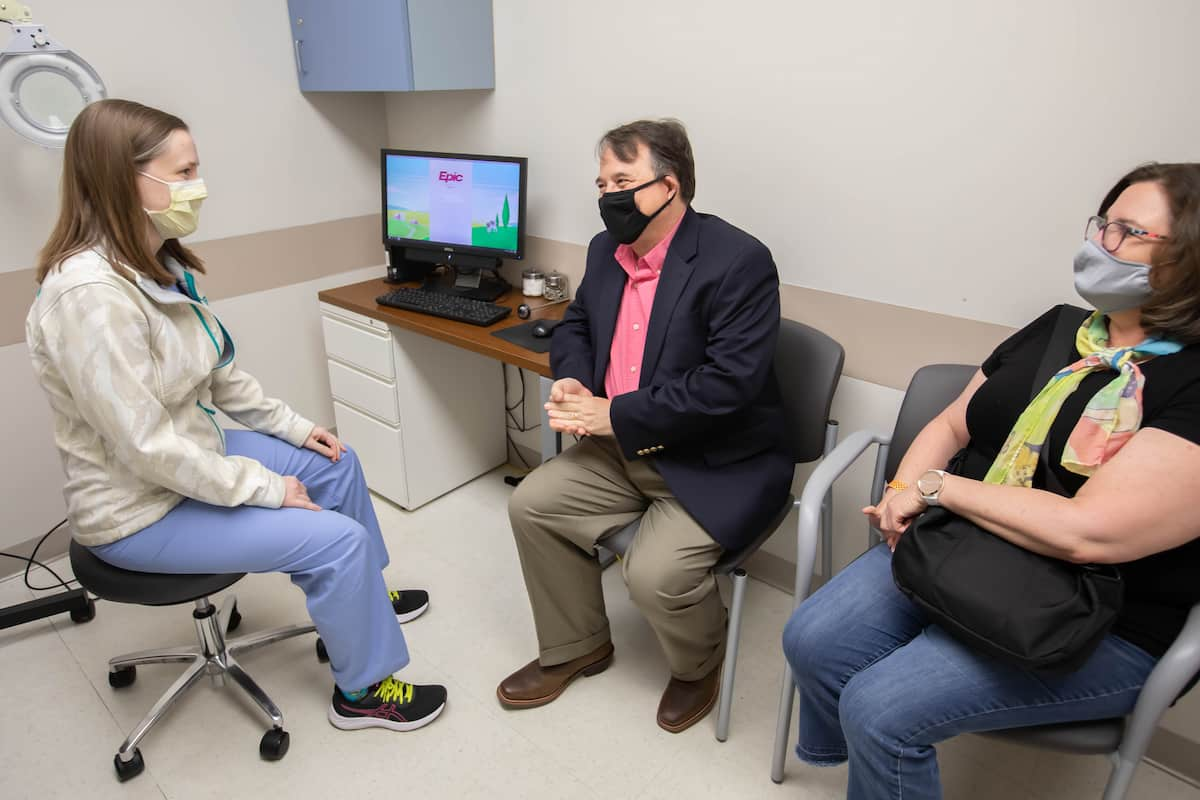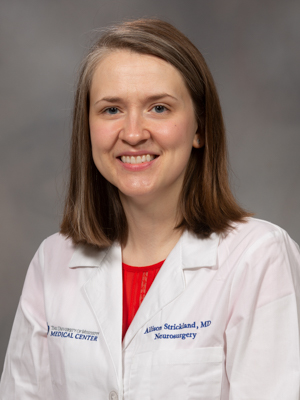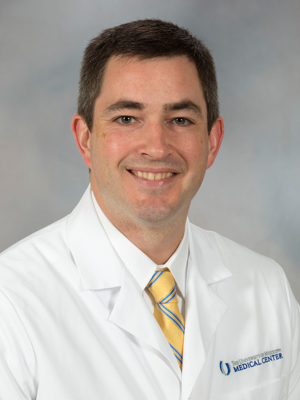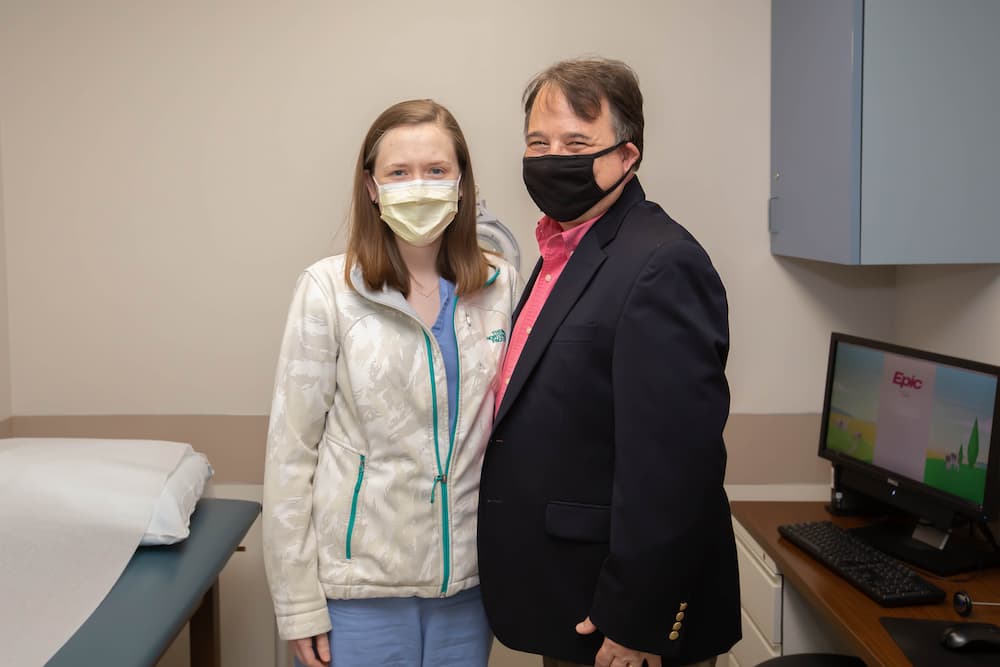Patient Story: Patrick Kerns - Aneurysm

Accompanied by his wife Lisa, Patrick Kerns chats with his neurosurgeon, Dr. Allison Strickland, during a checkup following his WEB procedure.
When Patrick Kerns had a stroke on Feb. 9, his CT scan at the University of Mississippi Medical Center revealed a brain bleed that could have killed him.
If that wasn’t enough, the scans showed an unexpected and not necessarily related problem: an aneurysm of his right internal carotid artery, a major artery that carries blood to the brain.
“It looked like the cutest little mushroom, but it wasn’t what you’d want on your brain,” said Kerns, 55, a Ridgeland resident who works remotely for a multinational financial services company. “It had a 3 millimeter opening and it was 5 millimeters across.”
Treatment for Kerns’ stroke was priority, but the aneurysm was a problem waiting to possibly grow worse. “I had to get my blood pressure under control before I did anything else,” Kerns said.
Kerns’ Department of Neurosurgery team at the Medical Center advised he have a procedure to embolize the aneurysm so that it wouldn’t burst. Traditionally, that’s been done by inserting small metal coils into the aneurysm, either by accessing an artery in the leg that runs to the brain, or accessing the aneurysm by going through a patient’s skull.
Kerns’ aneurysm was uncommon and often challenging due to its close proximity to the brain. Kerns “didn’t want his head cut open to clip the aneurysm,” said his surgeon, Dr. Allison Strickland, assistant professor of neurosurgery.
“We were initially going to do the coil,” Kerns said. “But, Dr. Strickland told me she had something wonderful and new, and that she thought I was the perfect candidate.”
On May 13, Strickland repaired Kerns’ aneurysm using a WEB device through an artery in his leg. The “WEB,” also known as a Woven EndoBridge System, is a tiny basket-like device made from very fine wires braided together to form a flexible, expanding mesh.

“The procedure is done in Interventional Radiology, in a biplane room,” Strickland said. UMMC’s state-of-the-art Interventional Radiology Suite opened in September 2020, offering the latest technology in a spacious, inviting treatment area for both diagnostic and outpatient procedures.
First, Kerns’ leg was sterilely cleaned. Then, Strickland used ultrasound to localize his artery. A sheath was placed into Kerns’ artery and a guide catheter was taken to the artery of interest in the brain.
Next, “we do an angiogram to study the arteries in the head and look at the aneurysm,” Strickland said. “Then, we do a 3-D angiogram using special software to get pictures so that we will know the size and shape of the aneurysm.
“I’ll set up a good view of the aneurysm to find the safest way to get into it,” Strickland said. Only then is a micro catheter placed into the aneurysm for treatment. The WEB is deployed through the micro catheter and placed inside the aneurysm.
Patients receive general anesthesia for the procedure, and they stay overnight for observation in the neuroscience ICU before going home the next day.
“The reason this device is so great is because you only have to use one for a wide-neck aneurysm,” Strickland said. The older procedure sometimes required placement both coils and stents, she said.
“More devices mean added risk. With this, you just open the web device into the aneurysm and it’s done,” she said. Patients like Kerns stay flat for two to four hours after the procedure as part of their recovery.
Although repairing Kerns’ aneurysm wasn’t immediately urgent, “it absolutely prevented a future rupture that could have led to death,” Strickland said.
Kerns said he suffered no ill effects from the surgery, which was on a Friday, and that he returned to work that Monday. “They put me to sleep, and then I woke up in the ICU and haven’t had any problems since.
“I was extremely pleased with all of the care I received from Dr. Strickland, her folks, and the folks in the ICU. They are first rate,”

Also, Strickland is uniquely qualified in the state to do the trans-radial WEB procedure, using the newest microcatheter, called a VS-17, to deploy the basket device through a patient’s arm. “Having brought in Dr. Strickland, we’ve expanded our coverage of neurosurgery endovascular services,” said Dr. Chad Washington, professor and chair of the Department of Neurosurgery. “She’s been a great addition to bringing the means and approach, and the techniques we can offer our patients.
“This allows us to tailor our treatment plans. We have a very patient-specific treatment plan based on individual needs.”
The trans-radial WEB procedure is just one example of new technology used by Department of Neurosurgery providers, Washington said. “We see lots of aneurysms and probably treat 200 a year at UMMC,” he said. “Each aneurysm is different, and each has a different treatment modality.
“The trans-radial WEB is good for certain types of aneurysms,” he said. “This device, and all of our techniques, are highly specialized options we provide to manage vascular conditions.”

Patrick Kerns and Dr. Allison Strickland
Kerns said he’s learned a valuable lesson from his stroke care and aneurysm repair. “Before the stroke, I was the reformed smoker that everybody hates,” he said. “And, I was one of those guys who thought, ‘Go to a doctor? No!’
“That worked really well for 55 years. I didn’t take any medications, or see any doctors, until I had a stroke, and I realized then my decision wasn’t the wisest one. I now have a primary care physician, a neurologist and a neurosurgeon. I collected a whole set.”
He took it easy for a while on Strickland’s orders and says lingering effects from his stroke have been his main challenge. “It just takes time,” he said of that recovery. “The (WEB) procedure was very low impact so far as the recovery. It was next to nothing.”
Strickland, Kerns said, “is my heroine. She’s good people.”


